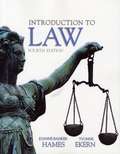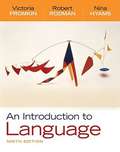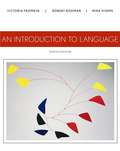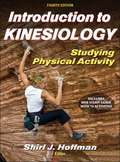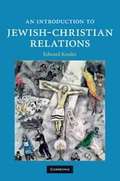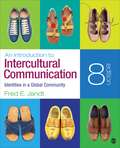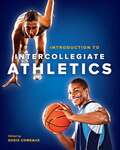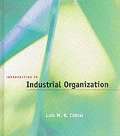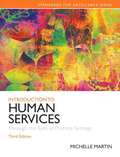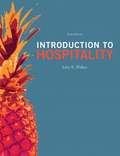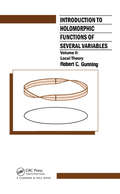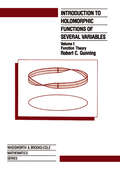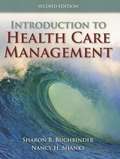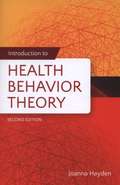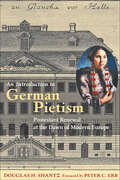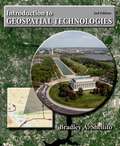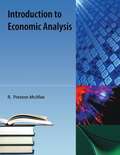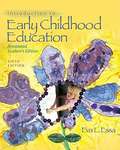- Table View
- List View
Introduction to Law (4th Edition)
by Joanne Banker Hames Yvonne EkernThis 4th edition aims to teach U.S. students the basic concepts related to substantive and procedural law, introduces them to cases, statutes, and the constitution, and develops their legal vocabulary and analytical skills. It contains a new chapter on constitutional law and expanded coverage of employment and environmental law.
An Introduction to Language (9th Edition)
by Victoria Fromkin Robert Rodman Nina HyamsAssuming no prior knowledge of linguistics, AN INTRODUCTION TO LANGUAGE, Ninth Edition, is appropriate for a variety of fields--including education, languages, psychology, anthropology, English, and teaching English as a Second Language (TESL)--at both the undergraduate and graduate levels. This completely updated edition retains the clear descriptions, humor, and seamless pedagogy that have made the text a perennial best-seller, while adding new information and exercises that render each topic fresh, engaging, and current.
An Introduction to Language
by Victoria Fromkin Robert Rodman Nina HyamsAssuming no prior knowledge of linguistics, AN INTRODUCTION TO LANGUAGE, Tenth Edition, is appropriate for a variety of fields--including education, languages, psychology, cognitive science, anthropology, English, and teaching English as a Second Language (TESL)--at both the undergraduate and graduate levels. This completely updated edition retains the clear descriptions, humor, and seamless pedagogy that have made the book a perennial best-seller, while adding new information and exercises that render each topic fresh, engaging, and current.
Introduction to Kinesiology: Studying Physical Activity
by Shirl J. HoffmanIntroduction to Kinesiology: Studying Physical Activity, Fourth Edition, is the most cohesive introduction to the field of kinesiology available, demonstrating how its many disciplines integrate into a unified body of knowledge. This all-inclusive approach gives students a solid background in the field and prepares them for further study and course work. This engaging and jargon-free text also introduces students to job prospects and areas of study and professional practice in kinesiology. Introduction to Kinesiology, Fourth Edition, orients and prepares students for in-depth studies in their areas of interest. Its broad scope acknowledges students' diverse interests and aspirations in professional and scholarly career tracks as well as teaching and coaching. Top kinesiologists expand discussion of physical activity beyond exercise, sport, or health-related activity in an effort to broaden conceptions of physical activity and the potential contributions of kinesiology. The contributors, each with specific expertise in the subdisciplines, share their perspectives in chapters complemented by full-color photos and illustrations.
An Introduction to Jewish-Christian Relations
by Edward KesslerRelations between Christians and Jews over the past two thousand years have been characterised to a great extent by mutual distrust and by Christian discrimination and violence against Jews. In recent decades, however, a new spirit of dialogue has been emerging, beginning with an awakening among Christians of the Jewish origins of Christianity, and encouraging scholars of both traditions to work together. An Introduction to Jewish-Christian Relations sheds fresh light on this ongoing interfaith encounter, exploring key writings and themes in Jewish-Christian history, from the Jewish context of the New Testament to major events of modern times, including the rise of ecumenism, the horrors of the Holocaust, and the creation of the state of Israel. This accessible theological and historical study also touches on numerous related areas such as Jewish and interfaith studies, philosophy, sociology, cultural studies, international relations and the political sciences.
Introduction to International Economics (Third Edition)
by Dominick SalvatoreThe aim of this text is to provide the student with an introduction to the field of international economics using many real-world case studies.
An Introduction to Intercultural Communication: Identities in a Global Community (Eighth Edition)
by Fred E. Edmund JandtAn Introduction to Intercultural Communication: Identities in a Global Community prepares today's students to successfully navigate our increasingly global community. Fred E. Jandt introduces essential communication skills and concepts that will empower readers to interact successfully with different cultures and ethnic groups. To spark student interest, Jandt offers readers unique insights into intercultural communication, at home and abroad, through an emphasis on history, culture, and popular media. Each chapter integrates material on social media, as well as extensive new examples from recent international news and events. Throughout the text, Jandt reinforces the important roles that stories, personal experiences, and self-reflection play in building our intercultural understanding and competence. The Eighth Edition adds depth to the coverage of theory and includes two new features: Focus on Skills provides expanded coverage of intercultural communication in practice, while Focus on Technology illustrates the impact of new communication technology on intercultural encounters. The new edition also introduces a new map program to provide students with additional context for discussion of cultures and regions across the globe.
Introduction to Intercollegiate Athletics
by Eddie ComeauxA comprehensive critical exploration of the intricacies of college-level athletics.Intercollegiate athletics continue to bedevil American higher education. At once tied closely with their institutions, athletic programs often operate outside the traditional university governance structure while contributing significantly to a school's culture, identity, and financial outlook. Introduction to Intercollegiate Athletics, edited by Eddie Comeaux, explores the complexities of intercollegiate athletics while explaining the organizational structures, key players, terms, and important issues most relevant to the growing but often misunderstood fields of recreational studies, sports management, and athletic administration.The book is divided into eight sections, the first three of which describe the foundations, overarching structures, and conditions that shape athletics and higher education. Three others explore the ways college athletes experience life on campus, and the final two delve into the current and future policy contexts of intercollegiate athletics. Written by a diverse group of expert scholars, the book's twenty-eight chapters are enhanced with useful glossaries, reflections from athletics stakeholders, relevant case studies, and conversation-provoking discussion questions. Aimed at upper-level undergraduate and graduate students, scholars, teachers, practitioners, athletic administrators, and advocates of intercollegiate athletics, Introduction to Intercollegiate Athletics provides readers with up-to-date and comprehensive knowledge about the changes to—and challenges faced by—university athletics programs.
Introduction to Industrial Organization
by Luís M. B. CabralOver the past twenty years, the study of industrial organization--the analysis of imperfectly competitive markets--has grown from a niche area of microeconomics to a key component of economics and of related disciplines such as finance, strategy, and marketing. This book provides an issue-driven introduction to industrial organization. It includes a vast array of examples, from both within and outside the United States. While formal in its approach, the book is written in a way that requires only basic mathematical training. Supplemental materials posted on the Web make more extensive use of algebra and calculus.
Introduction To Human Services: Through The Eyes Of Practice Settings
by Michelle E. MartinProvides readers with an understanding of the Human Services Profession. Introduction to Human Services: Through the Eyes of Practice Settings, 3/e explores human services through the lens of the most common practice settings where human service professionals work. This title also provides information about social problems within a socio-political context allowing readers to think about ways in which culture and ideology influence people's perspectives. Standards for Excellence series -- Each chapter highlights the national standards set by the Council for Standards in Human Service Education (CSHSE). Critical thinking questions throughout reinforces this integration. Learning Goals Upon completing this book, readers will be able to: Understand the issues pertinent to human services from new perspectives. Challenge the status quo of human services. Recognize their own stereotypical thinking that may create barriers to becoming effective helpers.
Introduction to Hospitality (6th edition)
by John R. WalkerThe Sixth Edition of Introduction to Hospitality focuses on hospitality operations while offering a broad, comprehensive foundation of current knowledge about the world's largest industry. The text is organized into five sections: the hospitality industry and tourism; lodging; restaurants, managed services, and beverages; recreation, theme parks, clubs, and gaming entertainment; and assemblies and event management.
Introduction to Holomorphic Functions of Several Variables, Volume II: Homological Theory
by R.C. GunningIntroduction to Holomorphlc Functions of SeveralVariables, Volumes 1-111 provide an extensiveintroduction to the Oka-Cartan theory of holomorphicfunctions of several variables and holomorphicvarieties. Each volume covers a different aspect andcan be read independently.
Introduction to Holomorphic Functions of Several Variables, Volume I: Homological Theory
by R.C. GunningIntroduction to Holomorphlc Functions of SeveralVariables, Volumes 1-111 provide an extensiveintroduction to the Oka-Cartan theory of holomorphicfunctions of several variables and holomorphicvarieties. Each volume covers a different aspect andcan be read independently.
Introduction To Health Care Management
by Sharon B. Buchbinder Nancy H. ShanksIntroduction to Health Care Management is a concise, reader-friendly, introductory healthcare management book that covers a wide variety of healthcare settings, from hospitals to nursing homes and clinics. Filled with examples to engage the reader's imagination, the important issues in healthcare management, such as ethics, cost management, strategic planning and marketing, information technology, and human resources, are all thoroughly covered. Guidelines and rubrics along with numerous case studies make this text both student-friendly and teacher friendly. It is the perfect resource for students of healthcare management, nursing, allied health, business administration, pharmacy, occupational therapy, public administration, and public health. "Drs. Buchbinder and Shanks have done a masterful job in selecting topics and authors and putting them together in a meaningful and coherent manner. Each chapter of the book is designed to give the student the core content that must become part of the repertoire of each and every healthcare manager, whether entry level or senior executive. Each of the chapters and accompanying cases serve to bring to life what it means to be a truly competent healthcare manager.
Introduction to Health Behavior Theory (Second Edition)
by Joanna Aboyoun HaydenIntroduction to Health Behavior Theory, Second Edition is designed to provide students with an easy to understand, interesting, and engaging introduction to the theoretical basis of health education. Written with the undergraduate in mind, the text uses comprehensive and accessible explanations to help students understand what theory is, how theories are developed, and what factors influence health behavior theory. Covering the more frequently used health behavior theories, the author breaks each theory into concepts and constructs to enhance comprehension and encourage students to discover how these theories can be put into practice. New to the Second Edition:* Data, information, and illustrations updated throughout, including the new "My Plate"* A new Theory in Action article and new classroom activities in each theory chapter* New and revised chapters on Social Ecological Models and Social Capital Theory
An Introduction to German Pietism: Protestant Renewal at the Dawn of Modern Europe (Young Center Books in Anabaptist and Pietist Studies)
by Douglas H. ShantzAn up-to-date portrait of a defining moment in the Christian story—its beginnings, worldview, and cultural significance.Winner of the Dale W. Brown Book Award of the Young Center for Anabaptists and Pietist Studies at Elizabethtown CollegeAn Introduction to German Pietism provides a scholarly investigation of a movement that changed the history of Protestantism. The Pietists can be credited with inspiring both Evangelicalism and modern individualism.Taking into account new discoveries in the field, Douglas H. Shantz focuses on features of Pietism that made it religiously and culturally significant. He discusses the social and religious roots of Pietism in earlier German Radicalism and situates Pietist beginnings in three cities: Frankfurt, Leipzig, and Halle. Shantz also examines the cultural worlds of the Pietists, including Pietism and gender, Pietists as readers and translators of the Bible, and Pietists as missionaries to the far reaches of the world. He not only considers Pietism's role in shaping modern western religion and culture but also reflects on the relevance of the Pietist religious paradigm of today.The first survey of German Pietism in English in forty years, An Introduction to German Pietism provides a narrative interpretation of the movement as a whole. The book's accessible tone and concise portrayal of an extensive and complex subject make it ideal for courses on early modern Christianity and German history. The book includes appendices with translations of German primary sources and discussion questions.
Introduction to Geospatial Technologies (Second Edition)
by Bradley A. ShellitoCombining both theoretical coverage and hands-on lab work, and accessible to majors and non-majors alike, Bradley Shellito's Introduction to Geospatial Technologies has become a new favorite for the digital Earth course. The new edition reflects the latest developments in the field, including how scientists are using GIS data with cloud technology. With lab activities that utilize both widely available freeware and ArcGIS, instructors can tailor the course to their students.
Introduction to Functional Magnetic Resonance Imaging
by Richard B. BuxtonFunctional Magnetic Resonance Imaging (fMRI) has become a standard tool for mapping the working brain's activation patterns, both in health and in disease. It is an interdisciplinary field and crosses the borders of neuroscience, psychology, psychiatry, radiology, mathematics, physics and engineering. Developments in techniques, procedures and our understanding of this field are expanding rapidly. In this second edition of Introduction to Functional Magnetic Resonance Imaging, Richard Buxton - a leading authority on fMRI - provides an invaluable guide to how fMRI works, from introducing the basic ideas and principles to the underlying physics and physiology. He covers the relationship between fMRI and other imaging techniques and includes a guide to the statistical analysis of fMRI data. This book will be useful both to the experienced radiographer, and the clinician or researcher with no previous knowledge of the technology.
Introduction to Food Science
by Rick Parker"Introduction to Food Science" provides an overview of the science of foods, from nutrition and digestion to processing and preservation. The material is based on a thorough, easy-to-follow outline that makes developing a lesson plan simple. Each chapter contains a list of learning objectives that help identify important concepts and key words that are essential to the understanding of the material. Tables, charts, graphs and illustrations are inserted throughout the text, providing quick and understandable access to information. The "student activities" section at the end of each chapter provide opportunities to directly apply material. The text also provides insight into career opportunities for those interested in working within food science industries.
Introduction to Environmental Science
by Susannah SandrinIntroduction To Environmental Science by Susannah Sandrin
Introduction to Economic Analysis
by R. Preston McafeeThis book presents introductory economics ("principles") material using standard mathematical tools, including calculus. It is designed for a relatively sophisticated undergraduate who has not taken a basic university course in economics. It also contains the standard intermediate microeconomics material and some material that ought to be standard but is not. The book can easily serve as an intermediate microeconomics text. The focus of this book is on the conceptual tools and not on fluff. Most microeconomics texts are mostly fluff and the fluff market is exceedingly over-served by $100+ texts. In contrast, this book reflects the approach actually adopted by the majority of economists for understanding economic activity. There are lots of models and equations and no pictures of economists.
Introduction to Economic Analysis
by R. Preston Mcafee Tracy R. LewisThis book presents standard intermediate microeconomics material and some material that, in the authors' view, ought to be standard but is not. Introductory economics material is integrated. Standard mathematical tools, including calculus, are used throughout. The book easily serves as an intermediate microeconomics text, and can be used for a relatively sophisticated undergraduate who has not taken a basic university course in economics. The focus of this book is on the conceptual tools and not on fluff. As such, it reflects the approach actually adopted by the majority of economists for understanding economic activity. There are lots of models and equations, and no pictures of economists ;-) Economic analysis is used in many situations. When British Petroleum sets the price for Alaskan crude oil, it uses an estimated demand model, both for gasoline consumers and also for the refineries to which BP sells. Economic analysis was used by experts in the antitrust suit brought by the U.S. Department of Justice both to understand Microsoft s incentive to foreclose (eliminate from the market) rival Netscape and consumer behavior in the face of alleged foreclosure. Stock market analysts use economic models to forecast the profits of companies to predict the price of their stocks. When the government forecasts the budget deficit or considers a change in environmental regulations, it uses economic models. This book presents the building blocks of the models in common use by an army of economists thousands of times per day. This book, plus econometrics, provides most of the economic analysis tools to take upper division economics courses of any type.
Introduction to Economic Analysis
by R. Preston Mcafee Tracy R. LewisThis book presents standard intermediate microeconomics material and some material that, in the authors' view, ought to be standard but is not. Introductory economics material is integrated. Standard mathematical tools, including calculus, are used throughout. The book easily serves as an intermediate microeconomics text, and can be used for a relatively sophisticated undergraduate who has not taken a basic university course in economics. The focus of this book is on the conceptual tools and not on fluff. As such, it reflects the approach actually adopted by the majority of economists for understanding economic activity. There are lots of models and equations, and no pictures of economists ;-) Economic analysis is used in many situations. When British Petroleum sets the price for Alaskan crude oil, it uses an estimated demand model, both for gasoline consumers and also for the refineries to which BP sells. Economic analysis was used by experts in the antitrust suit brought by the U.S. Department of Justice both to understand Microsoft s incentive to foreclose (eliminate from the market) rival Netscape and consumer behavior in the face of alleged foreclosure. Stock market analysts use economic models to forecast the profits of companies to predict the price of their stocks. When the government forecasts the budget deficit or considers a change in environmental regulations, it uses economic models. This book presents the building blocks of the models in common use by an army of economists thousands of times per day. This book, plus econometrics, provides most of the economic analysis tools to take upper division economics courses of any type.
Introduction to Early Childhood Education (6th Edition, Annotated Student’s Edition)
by Eva L. EssaThe book provides a comprehensive overview of early childhood education that is solidly based on current research and theories. The text, inter alia, examines curriculum and the fostering of creativity, as well as physical, cognitive, language, and social development--and every facet of early childhood education is examined and explained. This extensively revised edition includes new standards and accountability in the field of early childhood education.
An Introduction to Distributed Algorithms
by Valmir C. BarbosaAn Introduction to Distributed Algorithms takes up some of the main concepts and algorithms, ranging from basic to advanced techniques and applications, that underlie the programming of distributed-memory systems such as computer networks, networks of workstations, and multiprocessors. Written from the broad perspective of distributed-memory systems in general it includes topics such as algorithms for maximum flow, program debugging, and simulation that do not appear in more orthodox texts on distributed algorithms. Moving from fundamentals to advances and applications, ten chapters--with exercises and bibliographic notes--cover a variety of topics. These include models of distributed computation, information propagation, leader election, distributed snapshots, network synchronization, self- stability, termination detection, deadlock detection, graph algorithms, mutual exclusion, program debugging, and simulation. All of the algorithms are presented in a clear, template- based format for the description of message-passing computations among the nodes of a connected graph. Such a generic setting allows the treatment of problems originating from many different application areas. The main ideas and algorithms are described in a way that balances intuition and formal rigor--most are preceded by a general intuitive discussion and followed by formal statements as to correctness complexity or other properties.
